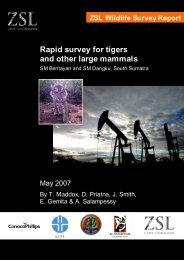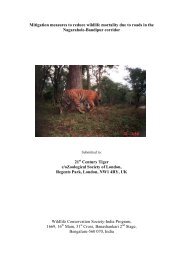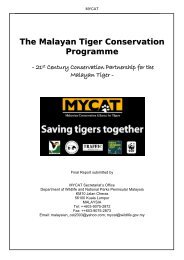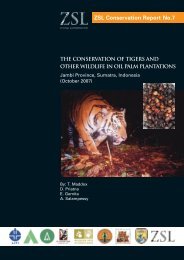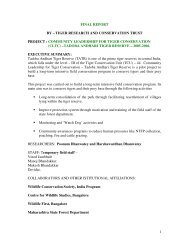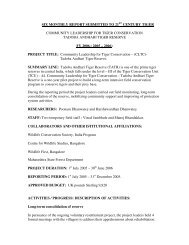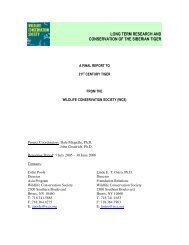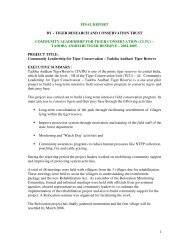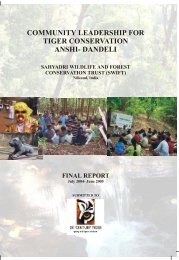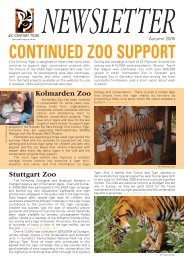21st Century Tiger Annual Report 2008 (PDF 2592Kb)
21st Century Tiger Annual Report 2008 (PDF 2592Kb)
21st Century Tiger Annual Report 2008 (PDF 2592Kb)
Create successful ePaper yourself
Turn your PDF publications into a flip-book with our unique Google optimized e-Paper software.
21 st <strong>Century</strong> <strong>Tiger</strong><br />
<strong>Annual</strong> <strong>Report</strong><br />
<strong>2008</strong><br />
21 st <strong>Century</strong> <strong>Tiger</strong> is a unique fundraising partnership between<br />
the Zoological Society of London and Global <strong>Tiger</strong> Patrol.
Contents<br />
About 21 st <strong>Century</strong> <strong>Tiger</strong> 3<br />
Our Mission 3<br />
Our Defining Features 3<br />
The Scope of Our Work 4<br />
Acknowledgements 5<br />
Funding 6<br />
Activities in <strong>2008</strong> 8<br />
Projects Funded in <strong>2008</strong> 10<br />
21 st <strong>Century</strong> <strong>Tiger</strong><br />
<strong>Annual</strong> <strong>Report</strong> <strong>2008</strong><br />
Contact details:<br />
21 st <strong>Century</strong> <strong>Tiger</strong><br />
C/o The Zoological Society of London<br />
Regent’s Park<br />
London<br />
NW1 4RY<br />
Email: <strong>21st</strong>centurytiger@zsl.org<br />
Tel: + 44 (0)20 7449 6444<br />
www.<strong>21st</strong>centurytiger.org<br />
2
About 21 st <strong>Century</strong> <strong>Tiger</strong><br />
21 st <strong>Century</strong> <strong>Tiger</strong> was established in 1997 as a unique fundraising partnership between<br />
the Zoological Society of London and Global <strong>Tiger</strong> Patrol. The aim is to pool resources<br />
in order to raise money and to source and support tiger conservation projects in the<br />
wild. Since its inception, 21 st <strong>Century</strong> <strong>Tiger</strong> has become one of the top six<br />
non-government organisations funding tiger conservation worldwide.<br />
A panel of international tiger experts rigorously examines all projects submitted to<br />
21 st <strong>Century</strong> <strong>Tiger</strong> for funding. The projects must have sound practical scientific and/or<br />
conservation value, and use local staff wherever possible. Project reports are reviewed<br />
every six months to ensure that the funds are being used to the best possible advantage.<br />
21 st <strong>Century</strong> <strong>Tiger</strong> is proud of its record of funding innovative projects which keep up<br />
with ever-changing environmental situations.<br />
Our Mission<br />
1. To raise funds, from government, the corporate sector, zoos and individuals, for<br />
projects which significantly contribute to the conservation of tigers in the wild.<br />
2. To raise the profile of tigers through developing public awareness and educational<br />
programmes.<br />
3. To work with the international conservation and scientific community.<br />
4. To utilise the wide range of resources held by the partnership between Global <strong>Tiger</strong><br />
Patrol and the Zoological Society of London.<br />
Our Defining Features<br />
• 100% of donations go directly to wild tiger projects.<br />
• Administration for the operation of 21 st <strong>Century</strong> <strong>Tiger</strong> is funded separately. Since<br />
November 2006 this administration has been kindly funded by Dreamworld,<br />
Gold Coast, Australia.<br />
• 21 st <strong>Century</strong> <strong>Tiger</strong> works closely with in-country counterparts in order to<br />
develop capacity within the country to sustain conservation work through the<br />
generations.<br />
• All projects are reviewed by experts to ensure that they have sound practical<br />
conservation and/or scientific credibility, and are making a fundamental<br />
contribution to the conservation of wild tigers.<br />
21 st <strong>Century</strong> <strong>Tiger</strong><br />
<strong>Annual</strong> <strong>Report</strong> <strong>2008</strong><br />
3
The Scope of Our Work<br />
Since its inception, 21 st <strong>Century</strong> <strong>Tiger</strong> has funded a total of 92 proposals from 56<br />
projects, distributing £1,300,000 and supporting projects in seven countries - India,<br />
Indonesia, China, Malaysia, Cambodia, Thailand and Russia. The projects cover a wide<br />
spectrum of requirements for tiger conservation, including training for wildlife rangers in<br />
the application of wildlife law, jungle survival and identification of endangered species,<br />
support for anti-poaching units which deal directly with poachers, uncover networks of<br />
illegal trading, and even advise in cases of human-tiger conflict. In Russia and Indonesia<br />
we also fund scientific research, including studies of tiger home ranges and tiger prey<br />
densities, and of methods for limiting the habitat damage caused by economic<br />
development. Comprehensive and thorough research provides a sound scientific basis<br />
for conservation planning and is an essential part of any conservation programme.<br />
Finally, 21 st <strong>Century</strong> <strong>Tiger</strong> also funds education and awareness raising programmes<br />
within tiger range countries; vital for ensuring sustainable local support for wildlife<br />
conservation.<br />
Graduate student Svetlana Soutryina checks a camera trap for the WCS project; Amur <strong>Tiger</strong>s and Far<br />
Eastern Leopards in Russia: Research, Training and Capacity Building in the Russian Far East. ©WCS<br />
Russia<br />
21 st <strong>Century</strong> <strong>Tiger</strong><br />
<strong>Annual</strong> <strong>Report</strong> <strong>2008</strong><br />
4
Acknowledgements<br />
21 st <strong>Century</strong> <strong>Tiger</strong> is most grateful to all its supporters who provide donations, both large and small, as<br />
well as those given in kind. We would particularly like to thank the following:<br />
Dreamworld on the Gold Coast of Australia who generously continued funding 21 st <strong>Century</strong> <strong>Tiger</strong>’s<br />
administration in <strong>2008</strong> allowing us to continue to spend 100% of funds raised on supporting wild tiger<br />
projects.<br />
The following zoos which have supported us in <strong>2008</strong>: Adelaide Zoological Gardens, Auckland Zoo,<br />
Blackpool Zoo, Dreamworld, Helsinki Zoo, Kolmardens Djurpark, Orana Wildlife Park,<br />
Shepreth Wildlife Park, and Taronga Zoo.<br />
EAZA (European Association of Zoos and Aquaria), ARAZPA (Australasian Regional Association of<br />
Zoological Parks and Aquaria).<br />
Founding supporter ExxonMobil, whose staff continue to support us each year through their retail<br />
department.<br />
BBC Wildlife Fund for their support of the project “Recovering wild tiger populations through habitatdefragmentation”<br />
The author, Joanna Skipwith, for the profits from her gorgeous book ‘<strong>Tiger</strong>, Animals in Art’.<br />
Harald Loeffler, Andy Rouse, Mike Vickers and all the other generous photographers who let us use their<br />
beautiful photos on our website to encourage fundraising.<br />
Hull City Association Football Club, “The <strong>Tiger</strong>s” for becoming our latest sponsor, supporting their wild<br />
cousins through fundraising efforts<br />
H. A. Bennett for their sponsorship through selling “tiger coffee” in Australia.<br />
Dave Pook of Sqoo Media for the design of our website and Candice Chitolie for producing our Zoo<br />
Supporters certificates.<br />
CMO Global for designing our online administration database.<br />
21 st <strong>Century</strong> <strong>Tiger</strong><br />
<strong>Annual</strong> <strong>Report</strong> <strong>2008</strong><br />
5
Funding<br />
Sources of funding for <strong>2008</strong><br />
Zoos<br />
Funding Source Amount Received<br />
Fundraising Activities<br />
£83,795<br />
ExxonMobil £4,099<br />
Public donations £7,595<br />
Other income (ticket sales &<br />
other toys & BBC)<br />
£6,1067<br />
Hull City Football £1,500<br />
H.A. Bennett £1,050<br />
Joanna Skipwith ‘<strong>Tiger</strong>, Animals<br />
in Art’<br />
£231<br />
Total<br />
21 st <strong>Century</strong> <strong>Tiger</strong> and Hull Mascot Roary © ZSL<br />
21 st <strong>Century</strong> <strong>Tiger</strong><br />
<strong>Annual</strong> <strong>Report</strong> <strong>2008</strong><br />
£159,337<br />
6
Projects receiving funding from 21 st <strong>Century</strong> <strong>Tiger</strong> in <strong>2008</strong><br />
Project Title Amount<br />
Granted<br />
Grantee<br />
Recovering wild tiger populations<br />
through habitat-defragmentation<br />
£57000* WCS - India<br />
Protection and Outreach - Russia £10,040 Phoenix<br />
Phoenix Fund for the Western<br />
Wildlife Managers Team - Russia<br />
£7,667* Phoenix<br />
The Khabarovsky Team’s Antipoaching<br />
activities of Inspection<br />
<strong>Tiger</strong> - Russia<br />
£17,563* Phoenix<br />
Anti-poaching activities in<br />
Lazovsky Reserve, Zapovednik -<br />
Russia<br />
£10,773* Phoenix<br />
Long term research and<br />
conservation of the Siberian tiger -<br />
Russia<br />
£10,104 WCS - Russia<br />
Swamp tigers <strong>2008</strong>. Conserving £13,000 Zoological Society of<br />
the tigers of the peatland forests<br />
of eastern Sumatra - Sumatra<br />
London – (ZSL)<br />
Kerinci Seblat tiger protection and £29925* Fauna & Flora<br />
conservation team - Sumatra<br />
International (FFI)<br />
Kerinci Seblat tiger protection £13000 Fauna & Flora<br />
project - Sumatra<br />
International (FFI)<br />
Total Granted £169072<br />
* Denotes a fully-funded project<br />
Russia<br />
33.21%<br />
Countries which were funded in <strong>2008</strong><br />
21 st <strong>Century</strong> <strong>Tiger</strong><br />
<strong>Annual</strong> <strong>Report</strong> <strong>2008</strong><br />
India<br />
33.71%<br />
Indonesia<br />
33.08%<br />
India 33.71%<br />
Indonesia 33.08%<br />
Russia 33.21%<br />
Total: 100.00%<br />
7
Activities in <strong>2008</strong><br />
Zoo Support<br />
Zoos continue to fundraise for tigers in the wild through 21 st <strong>Century</strong> <strong>Tiger</strong> with a<br />
range of different activities. Donations came from individual zoos in Europe, Canada and<br />
Australia. Zoos belonging to ARAZPA (Australasian Regional Association of Zoological<br />
Parks and Aquaria) raised more than £65,400 for tigers.<br />
21 st <strong>Century</strong> <strong>Tiger</strong> continues to recognise zoos’ fundraising achievements and features<br />
zoo support prominently on our website. 10 certificates were awarded during <strong>2008</strong>.<br />
Long term funding is vital and these efforts make a real impact on the ground in helping<br />
to conserve wild tigers.<br />
Fundraising<br />
<strong>Tiger</strong> Animals in Art, by Joanna Skipwith continued to be<br />
sold for 21 st <strong>Century</strong> <strong>Tiger</strong> during <strong>2008</strong>. It is available via the<br />
21 st <strong>Century</strong> <strong>Tiger</strong> website and from retailers across the<br />
country.<br />
Mike Curtis ran the BUPA Great North Run in October<br />
<strong>2008</strong> in a tiger suit and raised over £600.<br />
Sponsorship<br />
HA Bennett<br />
Hull City Association Football Club<br />
In <strong>2008</strong> Hull City “tigers” joined with 21 st <strong>Century</strong> <strong>Tiger</strong> to<br />
promote tiger conservation to their supporters. Since then<br />
promotional material has appeared in match day programmes,<br />
supporter’s magazine and the Hull City website. £1500 was raised<br />
on their Player of the Year night in <strong>2008</strong>.<br />
H.A. Bennett & Sons, importers and distributors of high quality green coffee to<br />
Australian based roasters, continue to be proud supporters of tiger conservation. They<br />
donate US$1 for every bag they sell of <strong>Tiger</strong> Mountain raw coffee beans. £1000 was<br />
donated in <strong>2008</strong>.<br />
21 st <strong>Century</strong> <strong>Tiger</strong><br />
<strong>Annual</strong> <strong>Report</strong> <strong>2008</strong><br />
8
ExxonMobil Toy Sale<br />
In <strong>2008</strong> over £3935 was raised through the support of ExxonMobil, including our 8 th<br />
annual toy sale held in ExxonMobil’s office in London in December selling cuddly tiger<br />
toys to the staff in time for Christmas. We would like to thank all at ExxonMobil,<br />
especially Stella Crossley and the staff and volunteers who helped us on the day.<br />
21 st <strong>Century</strong> <strong>Tiger</strong> Website<br />
The 21 st <strong>Century</strong> <strong>Tiger</strong> website went from strength<br />
to strength over the year and incorporated more<br />
information over more pages, with more<br />
photographs and reports from the projects<br />
including a new blog feature from the project<br />
workers in the field as well as attracting new<br />
supporters through social networking sites.<br />
Database<br />
The new 21 st <strong>Century</strong> <strong>Tiger</strong> database was populated with historical data. Much effort<br />
was put into this new administration database by CMO Global who offered their<br />
services pro bono. It has streamlined the recording of our administration data and<br />
allowed us to spend more time on much needed fundraising activities.<br />
21 st <strong>Century</strong> <strong>Tiger</strong><br />
<strong>Annual</strong> <strong>Report</strong> <strong>2008</strong><br />
9
Projects Funded in <strong>2008</strong><br />
21 st <strong>Century</strong> <strong>Tiger</strong> funded nine projects in <strong>2008</strong>. Here follows a selection:<br />
India<br />
Recovering wild tiger populations through habitat<br />
defragmentation (WCS-India fully-funded by BBC Wildlife Fund)<br />
In India, the Western Ghats of<br />
Karnataka are a global biodiversity<br />
hotspot. These mountains are<br />
biologically very rich and diverse and a<br />
string of protected areas has been<br />
established including Nagarahole<br />
National Park, Bandipur <strong>Tiger</strong> Reserve,<br />
Bhadra <strong>Tiger</strong> Reserve and Kudremukh<br />
National Park.<br />
In Kudremukh, biodiversity is<br />
threatened by illegal hunting and logging,<br />
over-harvest of non timber forest<br />
products, human induced fires,<br />
unregulated tourism, poorly planned,<br />
wildlife unfriendly development initiatives<br />
and excessive livestock grazing, much of<br />
21 st <strong>Century</strong> <strong>Tiger</strong><br />
<strong>Annual</strong> <strong>Report</strong> <strong>2008</strong><br />
One of the land enclosures within Kudremukh National Park<br />
that belonged to a family that was relocated under this project.<br />
© Centre for Wildlife Studies<br />
which is linked in some manner to the presence of enclaved human settlements within<br />
the National Park. Additionally, development in the form of roads, power lines,<br />
communication or other amenities, as well as new proposals to develop tourism that<br />
aim to provide social services to these families, pose serious long term threats in the<br />
form of habitat fragmentation and increased exploitation of wildlife and forests.<br />
This project aimed at preventing and reducing adverse human impacts such as hunting of<br />
tiger prey, direct persecution of tigers, encroachment of tiger habitat, man-made fires,<br />
fuel wood collection and livestock grazing. It aimed to reduce tiger-human conflict<br />
including attacks on livestock and humans and conflict between large herbivores such as<br />
wild pig, deer, elephants and humans.<br />
Finally, through well-implemented voluntary relocation packages, it aimed to<br />
substantially improve livelihood opportunities and access to modern development to<br />
local people living inside these tiger habitats, who are currently deprived of even basic<br />
amenities.<br />
After working with national and local government to set up a legal framework, the<br />
enclave of Singsara was indentified as a prime location. As a result of this project five<br />
families, (about 35 people) were compensated and voluntarily relocated outside and<br />
away from the National Park. Fourteen other families have agreed to accept suitable<br />
10
elocation packages. WCS continues to work with these families to ensure that they<br />
have access to post resettlement support. At Singsara, 29 hectares of land are now in<br />
the process of being legally added to the National Park.<br />
In addition to the work in Kudremurkh, inside Nagarahole National Park the entire<br />
community of Katibetta, a village of seven families have accepted the Government of<br />
India relocation package and are poised to move out.<br />
Russian Far East<br />
Long term research and conservation of the Siberian tiger –<br />
(WCS-Russia)<br />
Siberian <strong>Tiger</strong> Project field technician<br />
Vladimir Melnikov listens for radio-collared<br />
tiger. © Cheryl Hojnowski, WCS.<br />
WCS’s Siberian <strong>Tiger</strong> Project (STP) began in the<br />
Sikhote-Alin Biosphere Zapovednik (SABZ) in<br />
1992, when the Amur tiger’s ecology and status<br />
were little known outside the Soviet Union. STP<br />
objectives were straightforward: apply good<br />
science to Amur tiger conservation to supply the<br />
best possible information on the ecology and<br />
dynamics of the species, creating the necessary<br />
database for conservation planning to allow Amur<br />
tiger numbers to recover.<br />
This fascinating scientific project carried out field research in two areas in the Russian<br />
Far East, in SABZ and also in Southwest Primorye where tigers exist in a very small,<br />
isolated or semi-isolated subpopulation along the border with China and North Korea.<br />
Here research focuses on collecting biomedical and ecological data on Amur tigers.<br />
In SABZ, whilst tracking five radio-collared<br />
tigers, data was collected on movements,<br />
reproduction, the dispersal of subadults and<br />
predator/prey relations. Problems with<br />
permissions for the use of GPS collars held up<br />
their fitting until after the grant period<br />
covered, however two more were fitted in<br />
the autumn of 2009. The use of GPS in<br />
tracking tigers allows data to be recorded<br />
from areas where radio tracking from the<br />
ground is impossible.<br />
The impact of tigers on prey populations has been studied by scientists for many years,<br />
but the advent of GPS collars has revolutionized the study of kills. Recent studies have<br />
confirmed the utility of GPS collars to accurately estimate kill-rates of difficult to study<br />
tigers and to understand annual and summer kill-rates – something that has been difficult<br />
to do in the past.<br />
21 st <strong>Century</strong> <strong>Tiger</strong><br />
<strong>Annual</strong> <strong>Report</strong> <strong>2008</strong><br />
A camera-trap photo ©WCS<br />
11
During this period WCS also focused on training and capacity building, training 14<br />
graduate students and interns, including seven Russian and seven foreign nationals. Their<br />
work in the field contributed greatly to these projects. In the summer of <strong>2008</strong> the<br />
interior of the Sikhote-Alin Research Center was finished. This facility provides housing<br />
for graduate students, computer and internet access, and office space for graduate<br />
students and field technicians to access data forms, maps, etc.<br />
Sumatra<br />
Swamp tigers <strong>2008</strong>. Conserving the tigers of the peatland forests<br />
of eastern Sumatra - Sumatra (ZSL)<br />
The swamp forests of Jambi and South Sumatra provinces in eastern Sumatra are a<br />
recognised <strong>Tiger</strong> Conservation Landscape. Standing primarily on peat soils these forests<br />
also represent one of the largest carbon sequestration sites in Indonesia, holding an<br />
estimated 100 million tonnes of carbon in Jambi Province alone.<br />
As other available forests decline, pressure has been increasing on the swamp forest and<br />
this deforestation is the primary factor driving Indonesia’s greenhouse gas emissions.<br />
These emissions have driven Indonesia to be listed as the third largest emitter of<br />
greenhouse gases in the world, and have also led President Susilo Bambang Yudoyono to<br />
announce that Indonesia is becoming the first developing country to set emission<br />
reduction targets, aiming for 26% by 2020.<br />
Various mechanisms are in place, or under discussion, to provide the economic<br />
incentives to drive carbon emission reductions. Many of these focus on ‘avoided<br />
deforestation’ whereby financial rewards are offered for carbon credits generated by<br />
reducing deforestation from baseline ‘business as usual’ levels.<br />
Within the context of this background, ZSL designed the Berbak Carbon Initiative (BCI).<br />
The BCI aims to use the developing opportunities for avoided deforestation to provide<br />
an incentive for forest conservation, thereby conserving key tiger habitat – harnessing<br />
carbon to drive tiger conservation.<br />
The <strong>2008</strong>-9 21 st <strong>Century</strong> <strong>Tiger</strong> grant to ZSL was the<br />
first formal grant awarded to support the BCI. The<br />
initial activities led to a burgeoning interest in the<br />
Initiative and played a major part in securing additional<br />
funding from the Darwin Initiative, Save the <strong>Tiger</strong> Fund<br />
and USFWS Rhino and <strong>Tiger</strong> Conservation Fund,<br />
which means the BCI is now a reality with a very real<br />
chance of success.<br />
The upgraded Berbak base © ZSL<br />
Throughout <strong>2008</strong>-9 21 st <strong>Century</strong> <strong>Tiger</strong><br />
supported the establishment of a permanent<br />
field team and base for TN Berbak. Surveys<br />
were carried out to measure tiger and prey<br />
density in one pre- surveyed cell using<br />
capture-mark-recapture data from temporary<br />
21 st <strong>Century</strong> <strong>Tiger</strong><br />
<strong>Annual</strong> <strong>Report</strong> <strong>2008</strong><br />
The old National Park post at Berbak<br />
© ZSL<br />
12
cameratrap sites to estimate a population size for the park. Whilst camera trap sites<br />
have been established to set up permanent, long term tiger/wildlife monitoring, the<br />
permanent cameras are still not in place due to protracted negotiations with the park<br />
staff.<br />
<strong>Tiger</strong> identification from camera traps ©<br />
ZSL<br />
The trapping survey ran from mid July 2009 to mid<br />
October 2009. Twenty eight photographs of tigers<br />
were taken during this time, representing four<br />
individuals; two males, a female and one separate<br />
tiger of unknown sex. Twelve photographs were<br />
independent (ie taken more than one hour apart<br />
from the same camera station) and tigers were<br />
identified at seven sites. Almost all of the sites were<br />
very close to rivers.<br />
At the same time, 15 other species were photographed.<br />
Most were terrestrial mammals, with the most common being common pigs, pig tailed<br />
macaques and mouse deer, but two bird species were also photographed, one of which<br />
is the red listed (Threatened) crestless fireback which was photographed seven times.<br />
No sambars were photographed, leaving pigs as the most likely prey source for tigers.<br />
During this time the Berbak team also dealt with a<br />
series of human/tiger conflict issues, as eight people<br />
were either killed or hurt in tiger attacks in less<br />
than a month in the region. All those attacked<br />
were in areas of the forest they were not supposed<br />
to be in, often for illegal logging activities. ZSL<br />
assisted the authorities with the capture and<br />
relocation of a tiger during that time.<br />
21 st <strong>Century</strong> <strong>Tiger</strong><br />
<strong>Annual</strong> <strong>Report</strong> <strong>2008</strong><br />
Tortoise - captured on film © ZSL<br />
13




